Recent Posts
-
IDR 650K
Per Person
Kintamani Tour Bali
The Kintamani Tour package is a must for anyone visiting Bali, Indonesia. This tour visits some of the most beautiful and culturally significant places in Bali. From traditional performances of barong and keris dances to exploring ancient temples, this tour offers a rich and authentic Balinese experience.
The tour begins with a visit to Barong and Keris’s dance performance. This traditional Balinese dance represents the eternal struggle between good and evil. A must-see performance that showcases Bali’s rich culture and traditions.
Next, the Kintamani Tour will take you to Tegallalang Rice Terrace in Ubud, a beautiful rice terrace in the heart of Bali. A perfect place for nature lovers and photographers. Stroll through the rice terraces and enjoy the stunning scenery while learning traditional Balinese farming methods.
The next stop on the tour is Kintamani village. Here you will enjoy a traditional Balinese lunch with breathtaking views of Batur Volcano and Lake Batur. It’s a great opportunity to taste local Balinese cuisine while enjoying the beautiful scenery.
The tour also includes a visit to the temple of the sacred spring Tirta Empul. The temple is known for its holy water, which is said to have healing properties. Visitors can take a dip in the sacred waters and participate in a traditional Balinese purification ceremony. The final stop of the tour is Goa Gajah Temple, an ancient temple set in a beautiful rainforest. Known for its intricate stone carvings, the temple is believed to have been built in the 11th century.
Kintamani Tour package is an excellent way to experience the rich culture and natural beauty of Bali. From the performance of traditional barong and keris dances to the stunning views of Ubud’s Tegalalang Rice terrace, this tour offers a unique and authentic Balinese experience.
Place to Visit
Barong and Keris Dance Performance
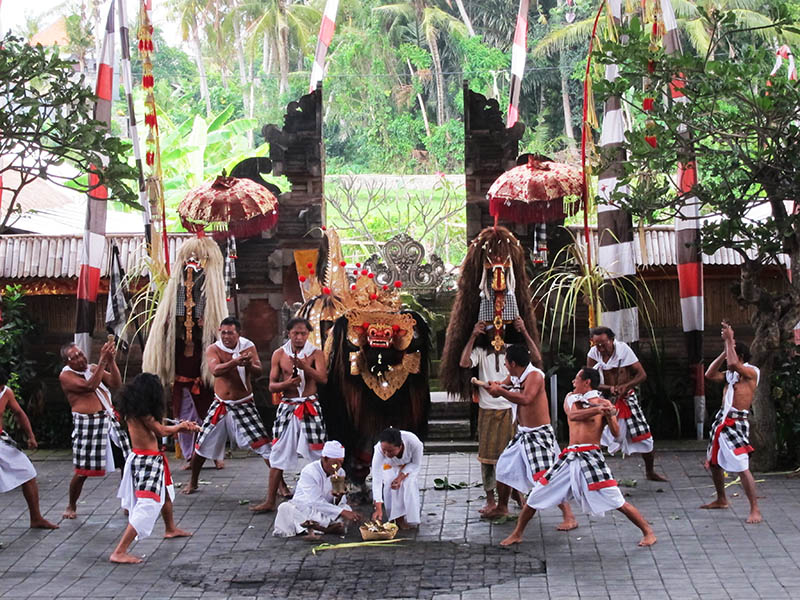
One of the most significant cultural events on the island is the Barong and Keris dance performance, a traditional Balinese dance. Whether there are formal ceremonies, festivals, or special occasions, this dance performance is typically presented in temples and public spaces.
Balinese mythology attributes good to the mythological Barong, while evil is symbolized by the ancient Indonesian dagger Keris. Barong and Keris are engaged in combat in the dance, and Barong is attempting to save the audience from Keris’ maliciousness. Character introductions are usually followed by a conflict between Barong and Keris at the start of performances.
The dance is complemented by traditional Balinese music performed on gamelan instruments, which adds to the performance’s enchanted mood. The dancers move gracefully and in unison while donning beautiful costumes.
Tegalalang Rice Terrace
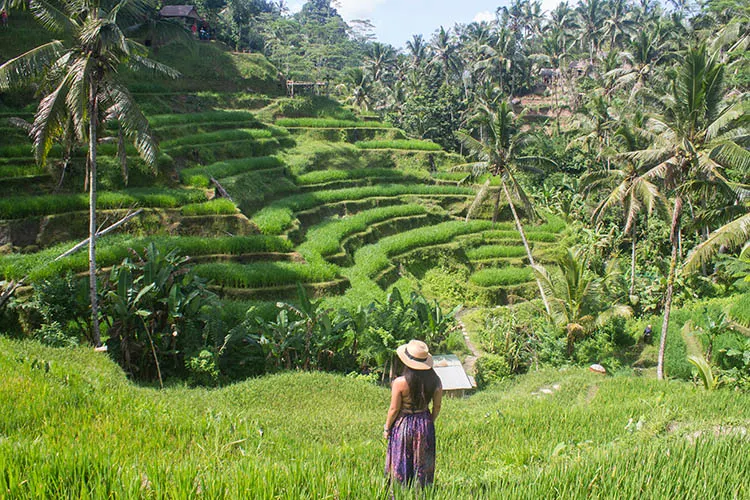
The Tegalalang Rice Terrace is one of Bali’s most famous and beautiful landscapes. The island’s long history of rice farming is attested to by the rice terraces, a cultural icon of Bali.
A complex irrigation system that has been passed down through generations of Balinese farmers was used to build the rice terraces. The method uses small channels to redirect water from rivers and streams into rice paddies. The procedure makes sure that the rice paddies have the right amount of water and nutrients for growing strong crops.
Visitors to the Tegalalang Rice Terrace have the chance to tour the terraces and discover how rice is traditionally farmed. The scenery makes for a beautiful backdrop for photos, thus there are numerous photo chances accessible.
There is an optional activity—the traditional Balinese swing—available for those seeking a distinctive experience. Visitors may swing above the rice terraces and take in the beautiful views from a unique vantage point thanks to the swing’s bamboo and rope construction.
It is advised to set aside at least an hour or two to tour the rice terraces and appreciate the natural beauty of the area. Also close are a number of local cafes and gift shops where tourists may try local food and buy souvenirs.
In general, those who are interested in Balinese culture and natural beauty should visit the Tegalalang Rice Terrace. It’s the ideal place to unwind and interact with the island’s rich cultural heritage thanks to its fascinating history, beautiful landscapes, and intriguing optional activity.
Kintamani Village
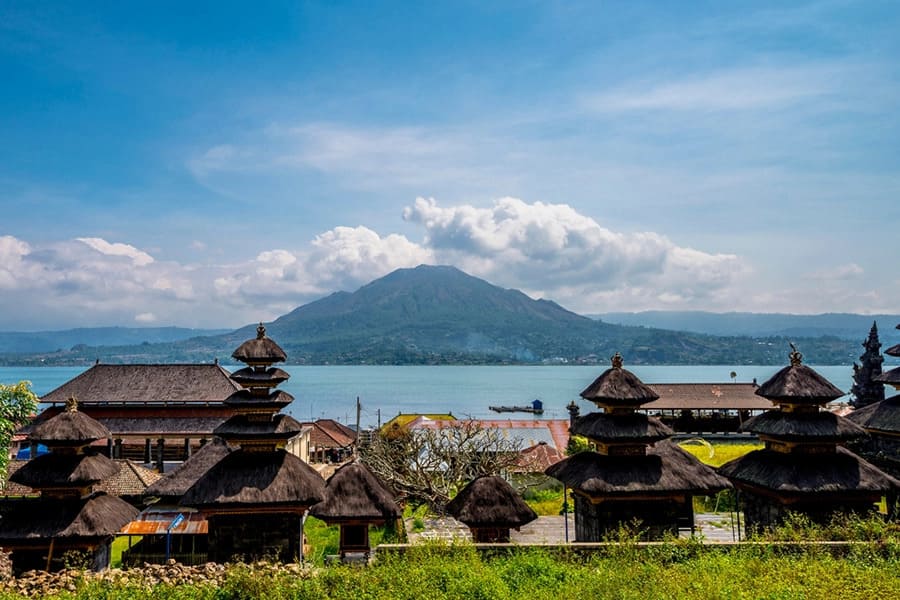
A small, traditional village called Kintamani Village may be found in Bali’s Kintamani district. The community is renowned for its outstanding natural surroundings, including breathtaking views of Mount Batur and Lake Batur, as well as its vibrant culture and history.
The Bali Aga people, one of Bali’s first residents, reside in the village and have managed to maintain their traditional way of life and rituals despite the area’s tremendous growth in tourism. Exploring the hamlet’s winding alleyways, going to the nearby markets, and taking in daily village life are all great ways for visitors to Kintamani Village to get a sense of the community’s distinctive culture and traditions.
Take a guided tour of the village, where tourists may learn about the history, culture, and way of life of the community from a local guide, as it is one of the most well-liked activities in Kintamani Village. The famed “babi guling” (roast suckling pig) and “ayam betutu” (chicken roasted with Balinese spices), which are available in neighborhood warungs, are only a couple of the traditional Balinese dishes that tourists can sample (small eateries).
Kintamani Village is renowned for its woodcarving and weaving traditions, and tourists can buy handcrafted fabrics and sculptures from regional craftspeople if they have an interest in handicrafts.
Visitors can get a rare look at Bali’s traditional culture and way of life at Kintamani Village. Guided tours of the village, tasting local cuisine, shopping for handcrafted fabrics and carvings, and discovering local markets are all optional activities.
Tirta Empul Holy Spring Temple
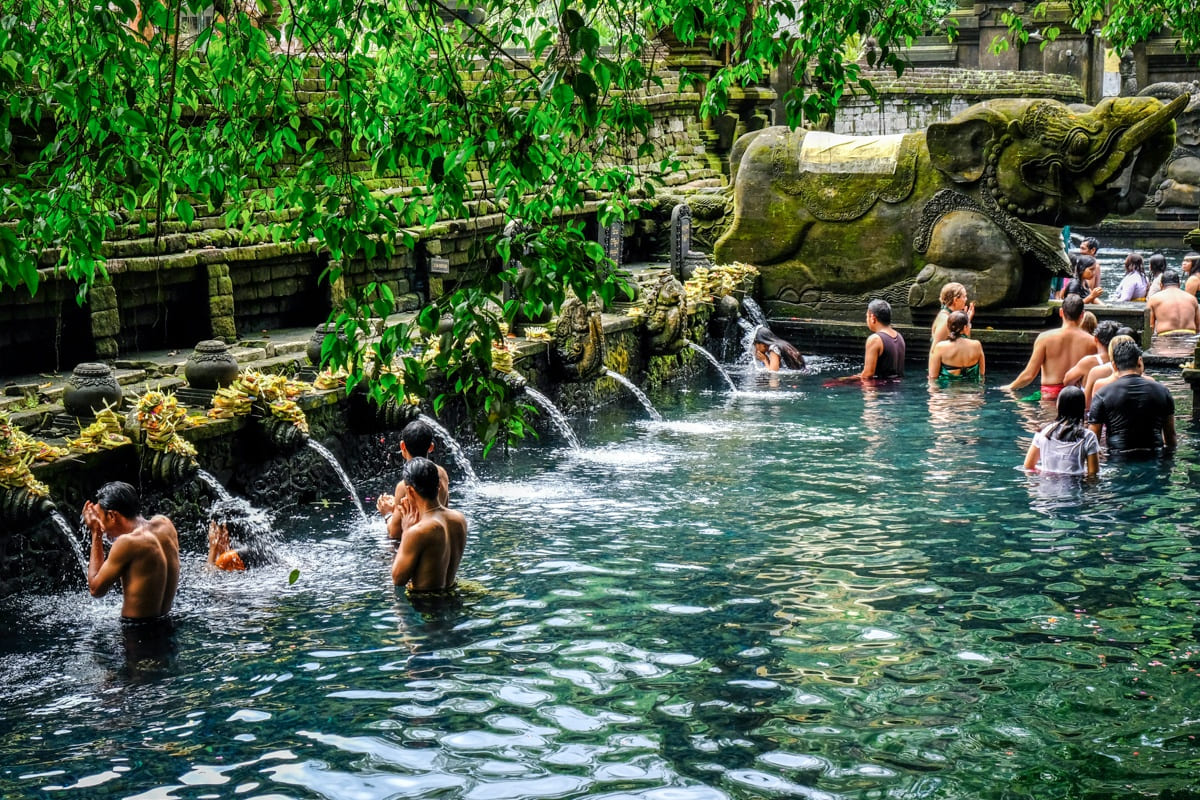
Tirta Empul Holy Spring Temple is a Hindu Balinese water temple located in the village of Tampak Siring, Bali. The temple was founded in 960 AD during the Warmadewa dynasty and was expanded during the rule of the Udayana dynasty in the 11th century.
The temple complex consists of three main sections: Jaba Pura (front yard), Jaba Tengah (central yard), and Jeroan (inner yard). Visitors must first pass through the Jaba Pura, which is the entrance to the temple. In the Jaba Tengah, visitors can see two pools of holy spring water where devotees perform a purification ritual called melukat.
The holy spring water is considered to have magical and curative powers. Balinese Hindus believe that water has the power to cleanse their soul and cure their illnesses. The temple’s name “Tirta Empul” means “holy water spring” in Balinese.
During the guided tour of the temple, visitors will be able to witness the purification ritual performed by devotees. The ritual involves a series of bathing and prayer sessions in the holy spring water. Devotees must wear traditional Balinese clothing and perform the ritual in silence to respect the sanctity of the temple.
Visitors can also see the temple’s unique architecture and intricate carvings, which depict scenes from Hindu mythology. The temple is surrounded by a beautiful garden with a lotus pond and is set against a backdrop of lush green hills.
The Tirta Empul holy spring temple is a significant cultural and spiritual site in Bali, offering visitors a glimpse into the Balinese Hindu culture and their beliefs in the magical powers of holy spring water. A guided tour of the temple is a must-do experience for those seeking to learn more about Bali’s unique cultural heritage.
Goa Gajah Temple (Elephant Cave Temple)
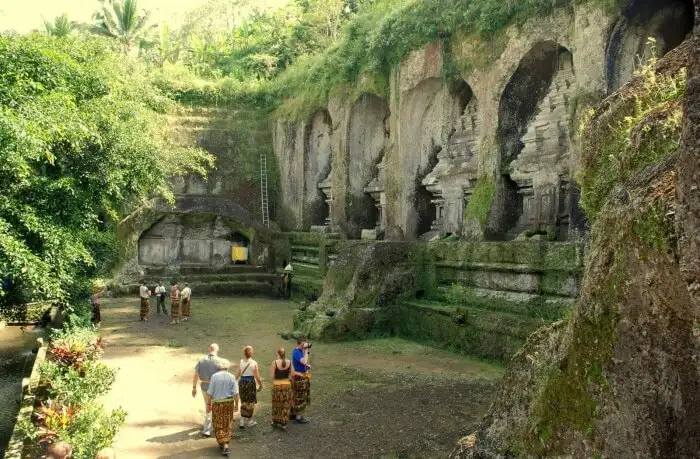
Hindu temple Goa Gajah Temple, often referred to as Elephant Cave Temple, is situated in Bedulu village, Bali. During the rule of the Balinese kingdom of Bedahulu, the temple is thought to have been constructed in the ninth century.
The history and significance of the temple are unknown, however, it is thought that Hindu priests used it as a place of meditation. The frightening beast that is carved into the cave’s entrance is thought to represent the underworld. There are several little recesses inside the cave that are thought to have been used for meditation.
The Indonesian name for the temple, “Goa Gajah,” means “Elephant Cave” in English. Unfortunately, the temple is devoid of any real elephants. The Petanu River, once known as the Elephant River, flows adjacent to the temple, which is thought to be where the name came from.
The temple’s exquisite sculptures are one of its key draws. Two dwarf statues stand guard at the entrance to the temple, while carvings of several Hindu gods and goddesses adorn the entrance to the cave. Moreover, there are several symbols and scenes from Hindu mythology carved into the cave’s inside.
Visitors may explore the cave and its surroundings while taking a guided tour of the temple. The tour will provide information about the temple’s background and importance as well as the significance of each carving.
A Buddhist stupa and a swimming pool are two other buildings that visitors may observe within the temple complex. Visitors may take a leisurely stroll around the verdant garden that surrounds the temple to take in its stunning surroundings.
A unique and remarkable temple, Goa Gajah Temple provides tourists with a window into Bali’s rich cultural past. Anybody interested in Balinese history and culture must visit the temple because of its elaborate carvings and enigmatic past. To truly comprehend the temple’s significance and beauty, a guided visit is strongly advised.
Take advantage of our Kintamani Tour to discover Bali’s cultural and natural attractions! See the majestic Tegalalang Rice Terrace, take in the serenity of Tirta Empul Holy Spring Temple, and be mesmerized by the Barong and Keris Dance.
Enjoy a scenic journey through Kintamani Village while learning about the mysticism and history of Goa Gajah Temple, also known as the Elephant Cave Temple. You will have an experience you won’t forget thanks to our skilled guide. Make Kintamani Tour reservations right away to make lifelong experiences!
Kintamani Tour Itinerary
08:00 – Pick up at the hotel
09.30 – Watching Barong and Keris Dance Performance
11.00 – Visit Tegalalang Rice Terrace
13.00 – Visit Kintamani Village
13.30 – Enjoy Lunch at Kintamani
15.00 – Visit Tirta Empul Holy Spring Temple
16.30 – Visit Goa Gajah Temple (Elephant Cave Temple)
17.30 – Back to the hotel
18.30 – Arrive at the hotel
Area Covered for Pick Up
Seminyak, Legian, Kuta, Nusa Dua, Jimbaran, Pecatu, Sanur, Ubud, Canggu, Denpasar, Benoa Harbour, Airport.
Please contact us for pick up in the different area.
Booking and Payment
- Fill in and submit the booking form
- Payment is Cash to your driver
-
DepartureHotel/ Villa
-
Departure Time8:00 AM
-
Return Time6:30 PM
-
IncludedPrivate tourComfortable Car with Air ConditionerSpeaking English DriverPetrol for carLunch at Ubud restaurant (set menu)Entrance Fee TicketsMineral waterParking feesGovernment taxes
-
Not IncludedPersonal expenses
Similar Tours
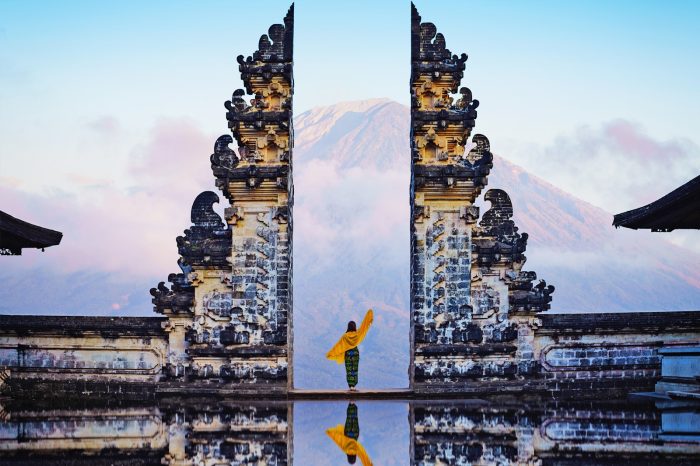
IDR 650K
Lempuyang Temple Bali Tour
Welcome to our Lempuyang Temple Bali Tour, a journey that will lead you past some of Bali’s most beautiful and famous sites. Our one-day tour package is made to provide you with a memorable experience that is packed with excitement, relaxation, and stunning surroundings.
Join Lempuyang Temple Bali Tour, also referred to as the “Gateway to Heaven,” and take a picture of you appearing to be heading upward with the spectacular Mount Agung in the background. The Tirta Gangga Water Palace, a magnificent royal residence with a labyrinth of ponds, fountains, and statues encircled by beautiful gardens, as well as the Tukad Cepung Waterfall, a hidden gem nestled away in a cave-like environment, will also be on our itinerary.
You will be led during the tour by one of our knowledgeable and personable tour guides, who will also make sure that you are secure and comfortable while giving you explicit consideration of Bali’s history and culture.
This Lempuyang Temple Bali Touris ideal for anyone seeking an adventure that combines Bali’s natural beauty and its extensive cultural legacy. So come and join Lempuyang Temple Bali Tour for a day that will leave you with lifelong memories that are truly unforgettable.
Place to Visit
Lempuyang Temple (Gate of Heaven)
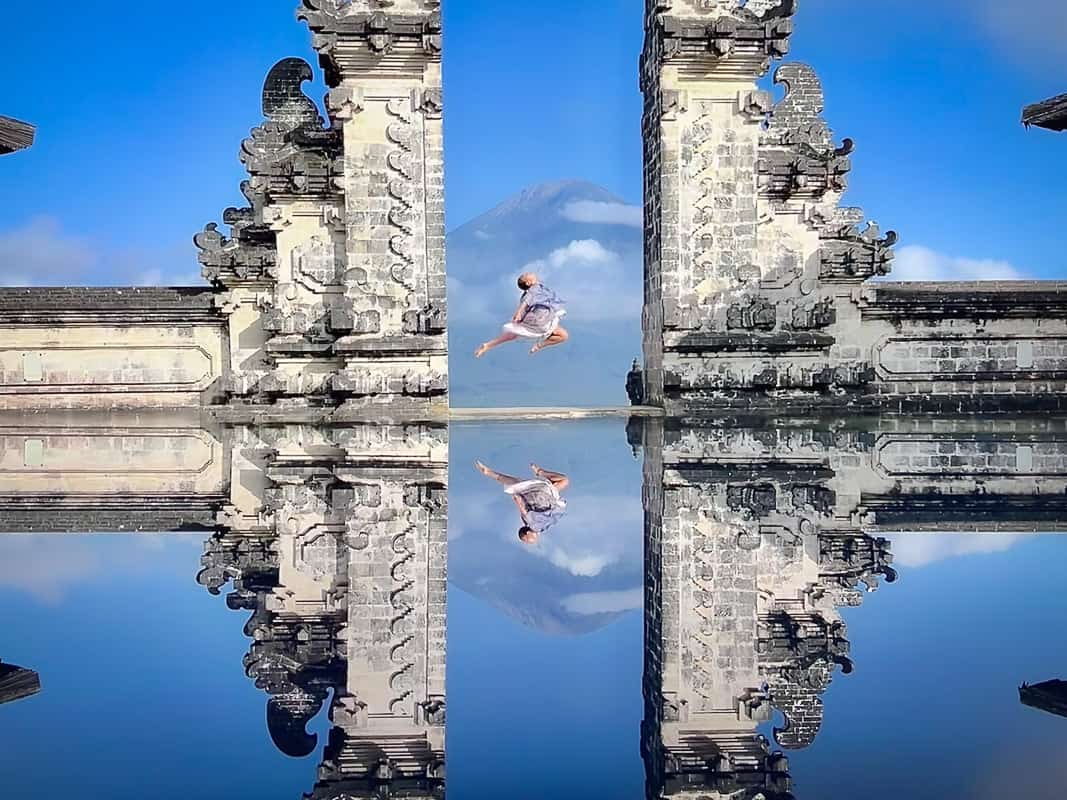
The complex of Balinese Hindu temples known as Lempuyang Temple is situated in East Bali, Indonesia. It is also referred to as Pura Lempuyang Luhur or the Gate of Heaven. It is located at an elevation of 1,175 meters above sea level on the slope of Mount Lempuyang and provides breathtaking views of the nearby hills and mountains.
Seven temples make up the complex, each of which is located on a different level and connected by a flight of stairs that leads to the main temple at the summit. Three imposing split gates, known as Candi Bentar and considered the entryway to the sacred sanctuary, mark the transition from the outside world to the inner realm of the gods in the main temple.
The Gate of Heaven, which is situated at the top of the stairs leading to the main temple, is the most well-known aspect of the Lempuyang Temple. The Gate of Heaven is a frame-like building that offers visitors a breathtaking photo opportunity by precisely framing the view of Mount Agung, Bali’s highest volcano.
Balinese Hindus consider the temple to be a significant place of worship and frequently come here to pray and make offerings to the gods. Guests are welcome to tour the temple grounds and observe the priests and worshippers performing their regular rituals.
The Lempuyang Temple entrance is free, but visitors must dress appropriately, which includes wearing a sarong and a sash. It’s also crucial to behave responsibly and avoid causing any disruptions in order to respect the temple and its holiness.
Tirta Gangga Water Palace
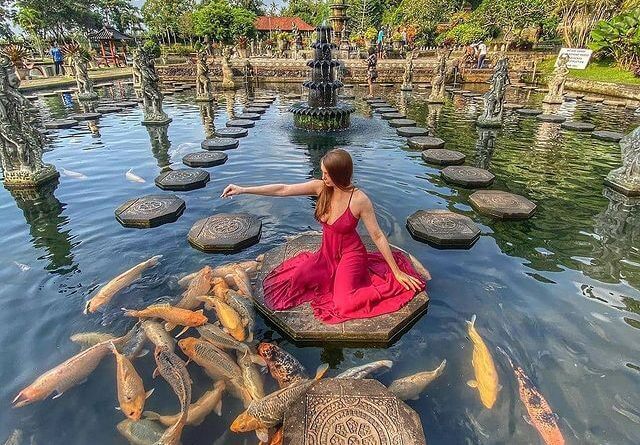
Tirta Gangga Water Palace is a popular major tourist destination in the eastern part of Bali, Indonesia. The palace was completed in 1946 by the last king of Karangasem, Anak Agung Anglurah Ketut Karangasem. It is a lovely complex of pools, fountains, and gardens nestled among lush green rice terraces and bordered by hills.
The water palace is notable for its gorgeous and elaborate Balinese architecture, which combines Hindu and Chinese elements. The palace is built around a natural spring that feeds three different pools, each with its own distinct personality and architecture.
The palace’s highlight is the first and largest pool, which is filled with crystal clear water teamed with koi fish. The second pool is the most sacred and is encircled by statues of mythical creatures. The third pool is a smaller, more secluded pool ideal for peaceful reflection and relaxation.
Aside from the pools, the palace has various exquisite fountains, stone carvings, and Hindu deity statues. The lovely gardens filled with brilliant flowers, coconut palms, and other tropical flora can be enjoyed by visitors as they stroll about the royal grounds.
Tirta Gangga Water Palace is not just a lovely tourist destination, but it also has cultural and religious significance for the Balinese. It is regarded as a spiritual healing center and is frequently utilized for religious ceremonies and rituals.
Tirta Gangga Water Palace is a must-see for anyone interested in Balinese culture and architecture, or who simply wants to escape the rush and bustle of daily life.
Tukad Cepung Waterfall
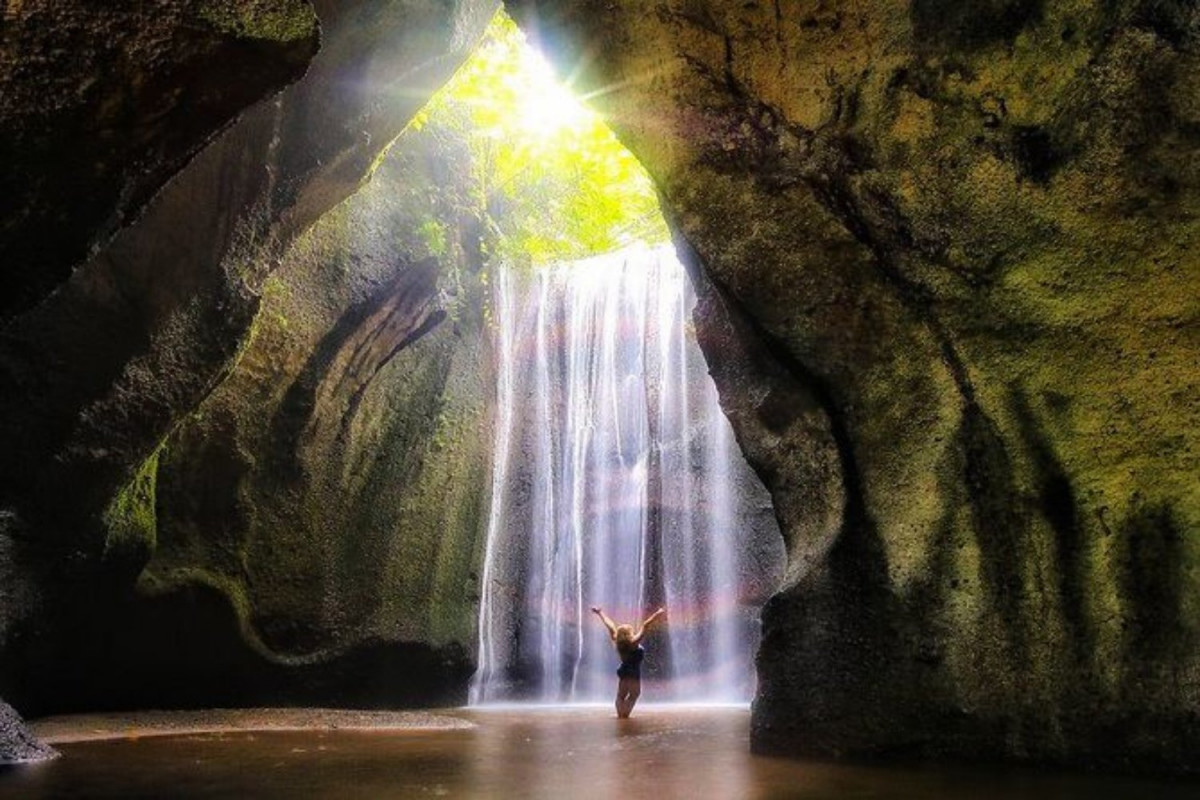
Tukad Cepung Waterfall is a hidden gem in Bali, Indonesia, located in the town of Tembuku, Bangli regency. It is a natural waterfall concealed inside a cave that is one of the island’s most remarkable and gorgeous waterfalls.
A stream passes through a short canyon and cascades into a pool below to make the waterfall. The waterfall is surrounded by steep rocks, and the sun’s rays filter through the narrow entrance of the cave, illuminating the cascade and the lake below.
Visitors must travel down a rough and slippery route through the lush jungle for about 15 minutes to reach the waterfall. The hike can be difficult, but it is well worth it for the breathtaking views of the waterfall and natural environs.
The greatest time to visit Tukad Cepung Waterfall is early in the morning when the sun’s rays are at their brightest and create the most magnificent light show. It is also less busy at this time, allowing tourists to experience the waterfall’s magnificence in private.
Guests can relax in the cool, soothing water of the pool below the waterfall. By the waterfall’s entrance, there are several tiny booths selling drinks and food.
Finally, Tukad Cepung Waterfall is a one-of-a-kind and spectacular location that nature enthusiasts and adventure seekers visiting Bali should not miss.
We appreciate your interest in our Lempuyang Temple Bali Tour! We think you’ll never forget your trip to the magnificent Lempuyang Temple (Gate of Heaven), the tranquil Tirta Gangga Water Palace, and the beautiful Tukad Cepung Waterfall. Your trip through the heart of Bali will be safe and unforgettable thanks to our skilled and hospitable guides.
Don’t pass it up this chance to see some of Bali’s most breathtaking sights. Make your reservation right away, and we’ll take you on an unforgettable journey!
Tour Itinerary
08:00 – Pick up at the hotel
11.00 – Visit Lempuyang Temple (Gate of Heaven)
13.00 – Visit Tirta Gangga Water Palace
14.00 – Lunch
15.30 – Visit Tukad Cepung Waterfall
16.30 – Back to the hotel
18.00 – Arrive at the hotel
Area Covered for Pick Up
Seminyak, Legian, Kuta, Nusa Dua, Jimbaran, Pecatu, Sanur, Ubud, Canggu, Denpasar, Benoa Harbour, Airport.
Please contact us for pick up in the different area.
Booking and Payment
- Fill in and submit the booking form
- Payment is Cash to your driver
1 day
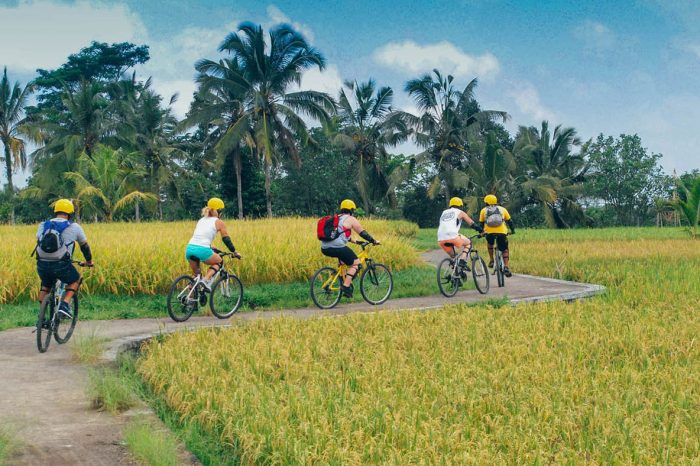
From IDR 450K
Kintamani Cycling Tour
The Kintamani cycling tour package is a popular tourist activity on the Indonesian island of Bali. It allows tourists to discover Bali’s magnificent countryside and gorgeous surroundings by cycling through villages, rice fields, and woods. The journey is ideal for nature lovers, adventure seekers, and those interested in learning about Balinese culture.
The journey normally begins with a hotel pickup, followed by a picturesque drive up to the Kintamani highlands. Visitors may enjoy a stunning view of Mount Batur, an active volcano, and the tranquil Lake Batur from here. The bike trip begins after a quick safety briefing and equipment check.
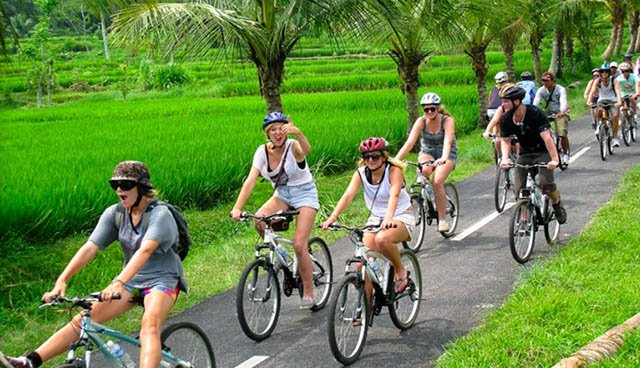
One of the tour’s highlights is a stop at a traditional Balinese home complex, where guests may get a sight of the native way of life and discover the Balinese people’s traditions and beliefs. As part of the tour, guests will also visit a coffee farm where they will get the opportunity to try some of Bali’s best coffee and tea.
Cycling through beautiful rice paddies and verdant woodlands, taking in the fresh air and breathtaking scenery, is part of the journey as it moves on. A delectable Balinese lunch and a ride back to the hotel mark the tour’s conclusion.
The Kintamani cycling tour package is a wonderful opportunity to discover Bali’s picturesque scenery and rich culture. Visitors may enjoy an exciting day of exploration and adventure with a well-thought-out itinerary and knowledgeable guides.
The Kintamani highlands are one of Bali’s most famous tourist destinations. The highlands, located at an elevation of 1,500 meters above sea level, provide tourists with a breathtaking view of Mount Batur and Lake Batur, one of Bali’s largest crater lakes.
From the Kintamani highlands, the view of Mount Batur is spectacular. Mount Batur is an active volcano that has erupted multiple times in the past, the most recent being in 2000. Mount Batur is a popular hiking destination, despite its active condition, and many people travel to Bali particularly to trek up to its peak.
Another natural beauty visible from the Kintamani highlands is Lake Batur, which is located at the base of Mount Batur. The lake is a big crater lake with a circumference of approximately 7 kilometers that is surrounded by hills and mountains. Guests may enjoy the tranquillity of the surrounding nature while taking in the placid beauty of Lake Batur from the hills.
Apart from the breathtaking views of Mount Batur and Lake Batur, the Kintamani highlands provide visitors with a cool and refreshing atmosphere that is a welcome relief from Bali’s tropical heat.
During the Kintamani cycling tour, tourists will have the option to visit a Traditional Balinese home compound, which provides insight into the Balinese people’s native culture, customs, and beliefs.
The Balinese home complex is a typical family housing characterized by its unique architecture and style. It usually consists of numerous structures, such as a main home, a family temple, a kitchen, and a rice barn. The houses are composed of wood and bamboo and have thatched roofs as well as elaborately carved doors and windows. The family temple, located in the middle of the courtyard, serves as the house’s spiritual core and is utilized for daily sacrifices and prayers.
A local family will be greeting visitors and accompanying them through the complex, providing insight into their everyday lives and rituals. Guests will learn about the significance of family and community in Balinese culture and see the traditional way of life that has been perpetuated for centuries.
Visitors to the traditional Balinese home compound can also learn about Balinese beliefs and spiritual practices. Guests will learn about the relevance of religion in Balinese culture, as well as the significance of daily offerings and rites done at the family temple.
The tour of the Balinese house complex also includes a typical Balinese lunch provided in a family-style setting. Guests will be able to sample a range of local delicacies cooked with fresh ingredients and traditional Balinese spices.
The Traditional Balinese home compound is a one-of-a-kind and enlightening experience that provides guests with an insight into the Balinese people’s lifestyle, customs, and beliefs. It is an excellent method to learn about Bali’s rich cultural heritage and to engage with the local people in a meaningful way.
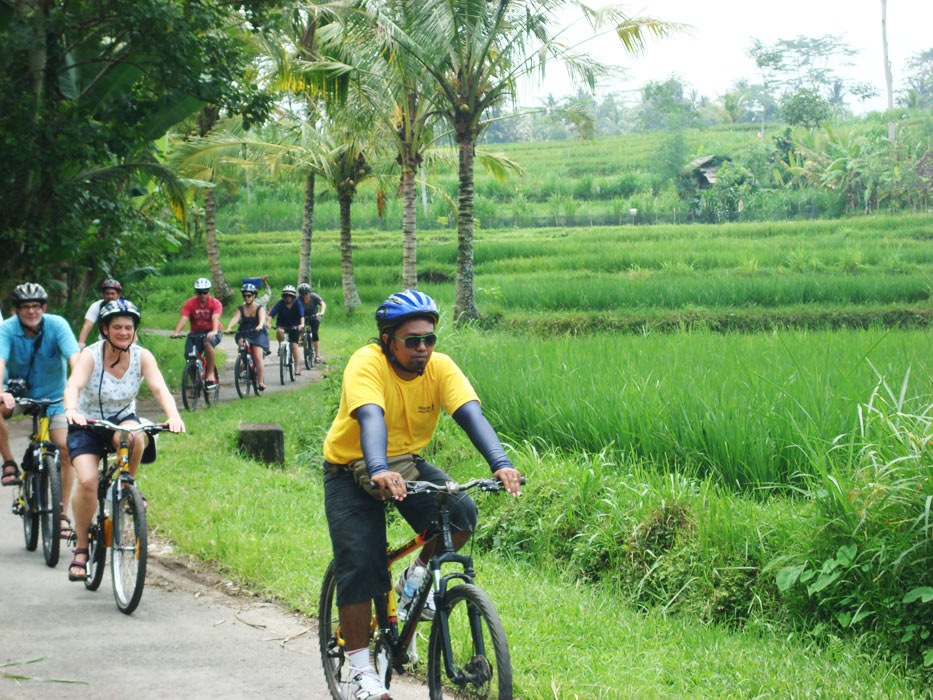
The Kintamani cycling tour takes you through the beautiful rice terraces and forests typical of the Bali scenery. The journey allows guests to take in Bali’s natural beauty while also enjoying the fresh air and tranquil ambiance of the countryside.
Bali’s rice paddies are a reflection of the island’s agricultural culture. The rice terraces are organized in a tiered pattern, creating a spectacular visual scene. Terraces are carved into the hillsides, resulting in a sequence of steps that flow down the slopes. The surrounding woodlands frame the green fields of the rice paddies, adding to the splendor of the environment.
Travelers will ride through the beautiful forests that cover most of Bali in addition to the rice terraces. The forests sustain an extensive range of plant and animal species and serve as a major source of oxygen and natural resources for the island. The journey through the trees allows tourists to take in the fresh air and relax in the calm and tranquillity of their surroundings.
The sounds of nature, such as birds singing and leaf rustling, will accompany tourists as they ride through the rice paddies and forests. The highlands’ cool and refreshing atmosphere adds to the whole experience, offering an escape from the tropical heat of the island’s coastal sections.
See Bali’s natural beauty and rich cultural legacy on the Kintamani cycling tour, a memorable journey. This tour is a must-do for anybody wanting to discover Bali’s hidden jewels since it offers breathtaking views of Mount Batur and Lake Batur, a trip to a traditional Balinese housing compound, and a ride through beautiful rice terraces and woods.
You will not only have the opportunity to see the gorgeous environment, but you will also learn about the Balinese people’s way of life, traditions, and beliefs. Your day of exploration and adventure will be made pleasant by affable and knowledgeable guides, who will also provide you with a comprehensive cultural experience.
So why wait? Discover the wonder of Bali’s scenery and culture by booking your Kintamani cycling tour right away. With so much to see and do, this tour is guaranteed to leave you with lifelong memories. Don’t pass up this chance to visit one of the most breathtaking places on earth.
Tour Itinerary
07.00 – Pick up at your hotel
09.00 – Breakfast at Kintamani with a view of Mount Batur volcano
10.00 – Go to starting point of Kintamani Cycling
10.30 – Enjoy the downhill Kintamani Cycling Tour
13.30 – Lunch
14.30 – Back to the hotel
16.00 – Arrive at the hotel
Tour Prices :
1 Person : IDR 950.000
2 Persons : IDR 700.000/person
3 Persons : IDR 600.000/person
4 Persons : IDR 550.000/person
5 Persons : IDR 500.000/person
6 Persons : IDR 450.000/person
Area Covered for Pick Up
Seminyak, Legian, Kuta, Nusa Dua, Jimbaran, Pecatu, Sanur, Ubud, Canggu, Denpasar, Benoa Harbour, Airport.
Please contact us for pick up in different area.
Booking and Payment
- Fill in and submit the booking form
- Payment is Cash to your driver
1 day
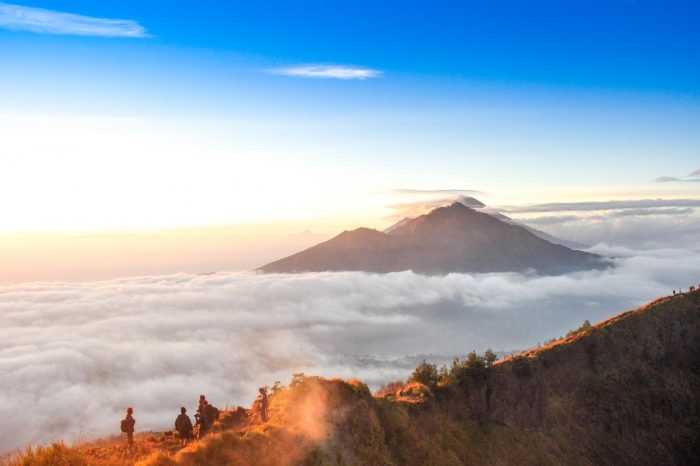
From IDR 450K
Mount Batur Bali Sunrise Tour
The Mount Batur Bali sunrise tour is an adventure that promises a unique experience for travelers looking for an adrenaline rush, stunning natural scenery, and cultural immersion. The hike itself is challenging, but accessible to most fitness levels, making it a popular activity for families, groups of friends, and solo travelers. The trek of Bali sunrise tour takes about two hours to reach the top, but it’s well worth the effort as visitors can take in stunning views of the sun rising over Bali.
The Bali sunrise tour starts early in the morning with pickup from your hotel in Bali. From there, visitors are transported to the base of the mountain where the hike begins. The trail is well-marked and relatively easy to walk but involves steep climbs, uneven terrain, and rock scrambling. Along the way, visitors can enjoy the scenic surroundings, including lush vegetation, small villages, and views of the lake below.
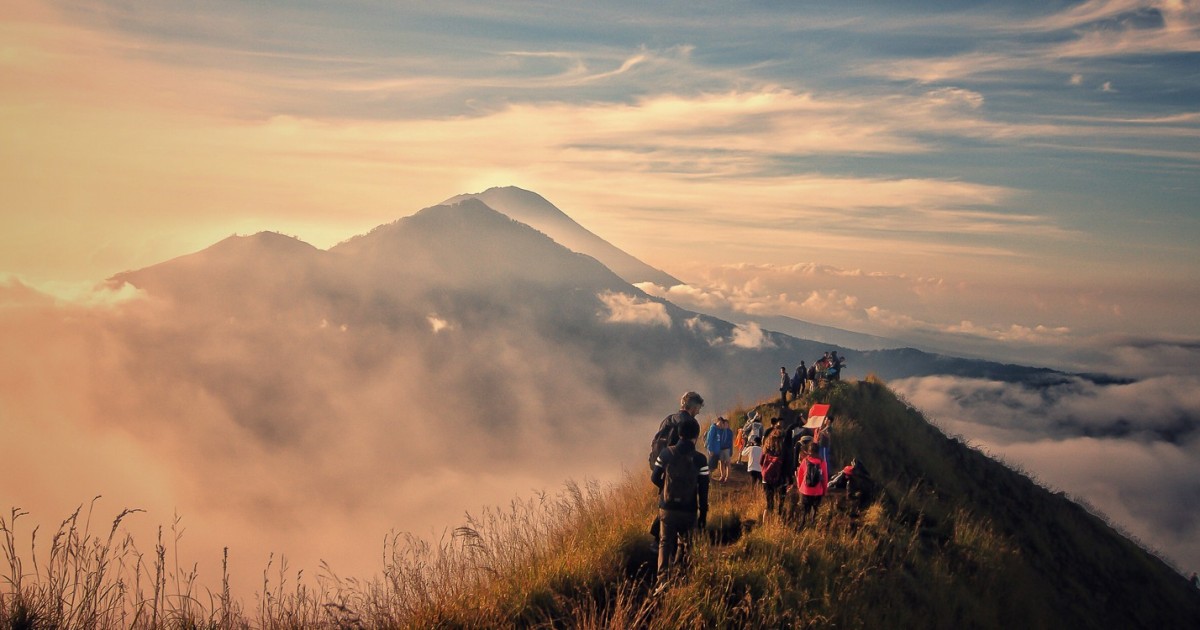
Upon reaching the summit, visitors are treated to an unforgettable Balinese sunrise view. The orange and pink tones of the rising sun reflecting off the clouds create a dramatic and breathtaking view that is truly awe-inspiring. Visitors can enjoy the scenery while enjoying a breakfast of eggs cooked in volcanic steam and hot drinks prepared by the guide. Your guide will also share information about the history and culture of the area, including the importance of Mount Batur to Balinese beliefs and traditions.
The descent from the mountain is easier than the ascent but requires careful gait and attention to the trail. Visitors have the opportunity to see volcanic fumaroles and volcanic craters up close, offering a unique perspective on the forces of nature that shape Bali’s landscape.
The Mount Batur Bali sunrise tour is a thrilling and rewarding experience that offers visitors the chance to explore Bali from a different perspective. The sense of accomplishment that comes from reaching the summit, combined with the stunning scenery and cultural insights, makes this tour a must-do for anyone visiting Bali.
Tour details
Meeting Point and Time
The Mount Batur Bali sunrise tour usually starts in the early morning, and the meeting point and time will be arranged with the tour operator. Typically, visitors will be picked up from their hotel in Bali and transported to the starting point of the hike.
Briefing about the Tour
Before beginning the hike, visitors will receive a briefing about the tour, including safety precautions, the itinerary, and any special considerations. The guide will explain what to expect during the hike, and answer any questions visitors may have.
Hiking Duration and Distance
The hiking duration and distance on the Mount Batur Bali hike tour can vary, but it typically takes about two hours to reach the summit. The distance covered is around 5 kilometers or 3 miles.
Starting Point and Route
The Mount Batur Bali sunrise tour normally begins at the mountain’s base, near the village of Toya Bungkah. Visitors will then follow a well-marked trail that makes its way up Mount Batur’s slopes. The trail is reasonably straightforward, but there are some steep inclines, rough terrain, and rock scrambling.
Difficulty Level and Required Fitness Level
The Mount Batur Bali sunrise tour is considered to be moderately difficult, with some steep inclines, uneven terrain, and rock scrambling. Visitors should have a basic level of fitness and be comfortable with hiking uphill for an extended period. While the hike is not suitable for those with mobility issues or severe health conditions, most people should be able to complete the hike with a reasonable level of fitness.
Safety Precautions
Safety is a top priority on the Mount Batur Bali sunrise tour, and visitors will be provided with appropriate safety equipment, including flashlights and helmets. The tour guide will also provide safety instructions before and during the hike, and will closely monitor visitors throughout the tour. Visitors should wear appropriate clothing and footwear for the hike, and bring plenty of water and sunscreen.
Hiking Experience
The Scenery and Landscapes
The Mount Batur Bali sunrise tour offers breathtaking landscapes, including glimpses of the lake below, little settlements, and lush greenery. Visitors may enjoy breathtaking panoramas of the surrounding area, which includes other volcanoes, rice terraces, and the ocean in the distance, as they ascend higher. It seems as though you are on top of the world because of the dramatic and breathtaking scenery.
Interesting Points Along the Way
The Mount Batur Bali sunrise tour passes through a number of noteworthy locations. Visitors will have the chance to witness the volcano’s crater and steam vents up close, offering a distinctive perspective on the natural forces that have shaped Bali’s terrain. Also, they will go through tiny towns where they may see how inhabitants live their everyday lives.
Importance of Mount Batur in Balinese Culture
Despite being an active volcano, Mount Batur is respected in Balinese culture. The island’s formation is thought to have been significantly influenced by the volcano, which is connected to the god Vishnu. The cultural significance of Mount Batur, particularly its involvement in regional rituals and traditions, will be discussed by the tour guide.
The Sunrise Experience
The highlight of the Mount Batur Bali sunrise tour is undoubtedly the sunrise experience. As visitors reach the summit, they will be treated to an unforgettable view of the sunrise over Bali. The orange and pink hues of the rising sun reflecting off the clouds create dramatic and stunning views that are truly awe-inspiring. Visitors can take in the views while enjoying a breakfast of eggs cooked in the volcanic steam and hot drinks, prepared by the guide. The guide will also share information about the history and culture of the area, including the significance of Mount Batur to Balinese beliefs and traditions.
The summit of Mount Batur provides a panoramic view of the surrounding area, including other volcanoes, rice terraces, and the ocean in the distance. Visitors can take photos to capture the stunning landscape and remember the experience forever. They can also take some time to relax and enjoy the view before beginning the descent back down the mountain.
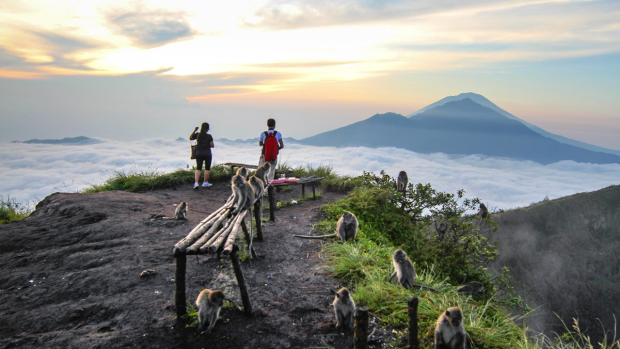
What to wear and bring
Proper attire and equipment are essential for a safe and enjoyable Mount Batur Bali sunrise tour. Visitors should consider the following recommendations:
Clothing: Wear comfortable, breathable clothing suitable for hiking, such as a t-shirt, shorts, or pants, and comfortable hiking shoes or trainers. It’s recommended to dress in layers as it can get cold at the summit, especially before sunrise.
Hat and Sunglasses: It’s essential to bring a hat and sunglasses to protect from the sun’s glare during the hike.
Sunscreen: Bali’s tropical climate means that the sun can be intense, so it’s crucial to apply sunscreen with a high SPF to protect the skin.
Water: Bring at least one liter of water to stay hydrated during the hike.
Snacks: It’s recommended to bring light snacks such as energy bars, fruits, or trail mix to fuel up during the hike.
Camera: Visitors should bring a camera or smartphone to capture the stunning views from the summit.
Backpack: A small backpack is recommended to carry all the essentials and avoid carrying anything in your hands during the hike.
Headlamp or Flashlight: As the hike begins before sunrise, it’s recommended to bring a headlamp or flashlight for the early morning trek.
By being well-prepared and bringing the right equipment, visitors can fully enjoy the Mount Batur Bali sunrise hike tour and create unforgettable memories
If you are looking for an unforgettable adventure and an opportunity to witness the natural beauty of Bali from a unique perspective, then the Mount Batur Bali sunrise tour is a must-do activity. This guided hiking tour offers visitors the chance to experience the stunning views of Bali while challenging themselves to conquer a volcano.
The tour is suitable for people of all ages and fitness levels, and safety precautions are taken to ensure that visitors have a safe and enjoyable experience. The hike is challenging, but the sense of accomplishment upon reaching the summit and witnessing the sunrise is worth it.
By joining the Mount Batur Bali sunrise tour, visitors can experience the cultural significance of Mount Batur in Balinese culture, witness the stunning landscapes of Bali, and capture unforgettable memories with their cameras.
So, what are you waiting for? Book your tour today and experience the thrill of hiking up a volcano, watching the sunrise over Bali, and creating unforgettable memories that will last a lifetime. Don’t miss out on this unique and exciting adventure!
Tour Prices :
1 person : IDR 1,200,000
2 persons : IDR 700,000/person
3 persons : IDR 525,000/person
4 persons : IDR 475,000/person
5 persons : IDR 450,000 or More
Area Covered for Pick Up
Seminyak, Legian, Kuta, Nusa Dua, Jimbaran, Pecatu, Sanur, Ubud, Canggu, Denpasar, Benoa Harbour, Airport.
Please contact us for pick up in different area.
Booking and Payment
- Fill in and submit the booking form
- Payment is Cash to your driver
1 day
